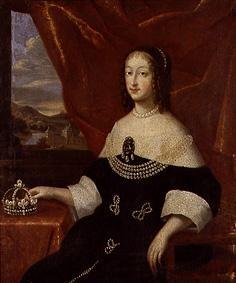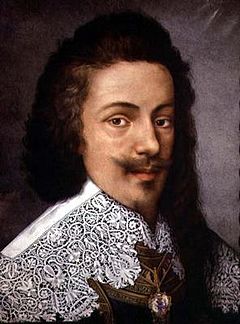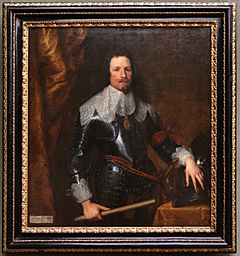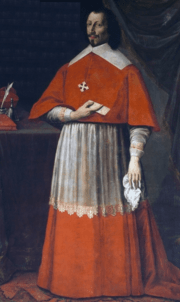Piedmontese Civil War facts for kids
Quick facts for kids Piedmontese Civil War |
|||||||
|---|---|---|---|---|---|---|---|
 Christine of France, Regent and head of the Madamisti faction |
|||||||
|
|||||||
| Belligerents | |||||||
| Commanders and leaders | |||||||
| Strength | |||||||
| 12,000 - 15,000 | 16,000 - 20,000 | ||||||
The Piedmontese Civil War, also known as the Savoyard Civil War, was a fight for control of the Savoyard state. This conflict lasted from 1639 to 1642. Even though it wasn't officially part of the larger Franco-Spanish War, both Habsburg Spain and France got involved. This was because Savoy was very important strategically. Spain controlled the nearby Duchy of Milan, and France wanted to limit Spanish power.
The war began after Victor Amadeus I, Duke of Savoy died in October 1637. His wife, Christine of France, became the Regent for their young son, Francis Hyacinth. When Francis also died in 1638, Christine continued to rule for her second son, Charles Emmanuel II. Christine's supporters were called the Madamisti (meaning 'Madam's faction').
However, two of Victor Amadeus's brothers, Prince Maurice of Savoy and Thomas Francis, Prince of Carignano, challenged Christine's rule. They led the Principisti (meaning 'Princes' faction'). After four years of fighting, Christine was confirmed as Regent. She kept this position until she died in 1663. As part of the peace deal, Prince Maurice married his niece, Princess Luisa Cristina of Savoy. He also became governor of Nice. Prince Thomas gained control of the fortresses of Biella and Ivrea. After the war, he fought for France.
Contents
Why the War Started: The Background

For hundreds of years, Northern Italy was a battleground between France and the Habsburgs. The Savoyard state was often called 'Savoy'. It was split into two main areas. Piedmont, where the capital Turin was located, and the Duchy of Aosta were on the Italian side of the Alps. The Duchy of Savoy and County of Nice were on the French side.
France wanted to control Piedmont. This would stop other powers from reaching its southern provinces. These areas, like the Dauphiné, had a history of rebellion. French control of Piedmont also threatened the Spanish-held Duchy of Milan. Milan was part of the Spanish Road, a land route connecting the Spanish Netherlands to Habsburg lands in Italy. This road was key for getting soldiers to the Army of Flanders.
Spain was very powerful, but its long supply lines were a weakness. Cardinal Richelieu, a powerful French minister, wanted to weaken Spain. He did this by attacking these supply routes. This led France to get involved in the 1628-1631 War of the Mantuan Succession. This war ended with France's chosen leader, Charles I Gonzaga, ruling the Duchy of Mantua. French troops were also placed in the Savoyard fortresses of Pinerolo and Casale. These positions protected the Alpine passes into Southern France. They also allowed France to threaten Milan.
These fortresses were also vital for Savoy's safety. This gave France a way to control Victor Amadeus I, Duke of Savoy. His wife, Christine Marie of France, was the sister of Louis XIII of France. Victor Amadeus tried to stay neutral between France and Spain. His younger brother, Thomas Francis, Prince of Carignano, was a skilled military leader. He commanded Spanish troops against France. His other brother, Prince Maurice of Savoy, was a Catholic Cardinal. He switched his loyalty to the Holy Roman Empire in 1636.

When the Franco-Spanish War began in 1635, Richelieu supported Savoyard attacks on Milan. This was to tie down Spanish resources. These attacks included a failed attempt on Valenza in 1635. There were also small victories at Tornavento and Mombaldone. In June 1637, Leganés, the Spanish governor of Milan, captured the Savoyard town of Vercelli. The alliance against the Habsburgs in Northern Italy fell apart when Charles of Mantua died in September. Victor Amadeus died the next month.
Victor Amadeus's heir, Francis Hyacinth, was only five years old. His will named Christine as Regent. Despite her French family ties, Christine tried to keep Savoy independent. But she had limited choices because French troops were present, and she lacked money. Her two brothers-in-law suspected France wanted to take over Savoy. This was a real concern, as controlling Savoy was part of Richelieu's plan against the Habsburgs.
In October 1638, Francis died. His four-year-old brother, Charles Emmanuel, became the new Duke. Christine continued as regent, but this was not covered by Victor Amadeus's will. Maurice and Thomas argued that her position needed approval. It had to be approved either by the Savoy Estates (a kind of parliament) or the Holy Roman Emperor. The Emperor was technically the overlord of the duchy.
The Princes, or 'Principisti', had a lot of support from ordinary people in Piedmont. They disliked the French presence. Those who supported Christine, the 'Madamisti', included powerful families like the d'Aglié clan. But the situation was very complicated. The 'Principisti' were also worried about Spain's plans for Savoy. Some supported Maurice more than Thomas. There were also many personal connections between the two sides.
At the end of 1638, Thomas went to Madrid to get Spanish help. He wasn't fully trusted because his wife, Marie de Bourbon, was part of the French Royal family. So, she and their children lived in Madrid as hostages. This was to ensure his good behavior. In March 1639, Richelieu ordered his commanders to arrest Thomas if he entered Savoy. Louis XIII also wrote to Christine, telling her to keep both Thomas and Maurice out of Piedmont.
Phase One: The Early Years (1639-1640)
The Princes had an agreement: they would keep any towns that surrendered without a fight. The Spanish would get towns taken by force. This deal wasn't as good as it seemed. The most important towns were held by the French, who would fight back. This meant possibly trading French control for Spanish control. In March 1639, Thomas entered Piedmont. He quickly took Chieri, Moncalieri, Ivrea, Verrua, and Chivasso. But the main prize was Turin, which had a French army. Whoever held Turin controlled Piedmont. So, a deal was needed. Thomas secretly started talking with Christine. Richelieu supposedly offered Thomas money and positions if he switched sides.
In June, Christine gave Cherasco and Carmagnola to France. In return, she received a million Écus each year. She also agreed to discuss the future of Savoyard lands, including the County of Nice. The Princes said this was a betrayal. But they blamed it on "ambitious courtiers" like the d'Aglié family. Maurice took Nice. Thomas entered Turin in July with 12,000 soldiers, helped by his supporters inside the city.
Christine and Charles Emmanuel escaped to the Citadel in Turin. It was held by a well-supplied French army. The Citadel was built between 1564 and 1577 and was thought to be impossible to capture. After failing to take back the city, Christine made a truce with Thomas until October 24. They continued their talks. During this time, Richelieu sent one of his best commanders, the Comte d'Harcourt, to lead French troops in Pinerolo.

When the truce ended, Harcourt attacked Chieri. This distracted attention from a supply convoy heading to his army at Casale. However, Leganés advanced on Chieri from the south. Thomas marched out of Turin. Harcourt was threatened from two sides. He pulled back towards Pinerolo on November 20. But he found his path blocked by the Spanish. Even though they had more soldiers, Thomas and Leganés didn't work together. This allowed Harcourt to defeat them separately in an action called La Rotta. A rear guard led by Turenne covered the French retreat. The French regrouped at Carignano before returning to Pinerolo.
Thomas continued to block Turin's citadel. Leganés surrounded Casale. In April 1640, Harcourt marched to help Casale with 10,000 men. He split his army into three parts, led by himself, Turenne, and La Mothe-Houdancourt. They attacked the Spanish lines on April 29. After hours of hard fighting, Leganés pulled back. He reportedly lost over 3,000 soldiers, many of whom drowned when a bridge collapsed.
Harcourt then entered Turin. This began one of the most complex military events of the 17th century. A small French army in the citadel was blocked by 12,000 of Thomas's troops. Harcourt then surrounded Thomas. By the end of May, Harcourt was himself surrounded by 18,000 Spanish relief forces under Leganés. After their defeat at Casale, the Spanish didn't want to risk attacking the French. They also couldn't keep Thomas supplied. Thomas believed Leganés was trying to undermine him. So, he made a deal with Harcourt. On September 24, he left Turin and went back to his base at Ivrea.
Phase Two: The Final Years (1641-1642)
During the winter, Thomas talked with Richelieu. He hoped to secure Savoy's independence and stop the damage to Piedmont. Leganés had been replaced as the Habsburg commander by Cardinal Trivulzio. He tried to support Thomas as best he could. But in 1640, protests against tax increases led to revolts in Portugal and Catalonia. Spain desperately needed soldiers and money. So, they mostly stopped military actions in Northern Italy.
This situation sped up talks between the Princes, Richelieu, and Christine. Even though her position was weak, Christine insisted on being the head of state. She also wanted to compensate Thomas and Maurice. Richelieu was furious that she wouldn't give in on these points. In his private letters, he called her "stubborn" and "weak." He also said she was controlled by her ministers. These opinions influenced how later historians, especially French ones, saw Christine.
When Thomas's brother-in-law, the Comte de Soissons, was killed at La Marfée in July 1641, his sister Marie became his heir. This gave Richelieu a strong bargaining tool. Two treaties were finally signed in Turin in June 1642. The first was between France and the Princes. The Princes agreed to serve France and return the lands they had taken to Christine. In return, Thomas received a pension and his wife's inheritance. He also got help to free his family from Spain. Maurice was made governor of Nice. He also gave up his role as cardinal to marry his niece, Princess Luisa Cristina of Savoy.
The second treaty was between Christine and her brothers-in-law. It repeated the terms of the first treaty. Thomas was also given control of Biella and Ivrea for as long as Christine was regent. Both sides agreed to release their prisoners without asking for money. They also confirmed the officials already in place. Christine agreed to include Thomas and Maurice in important state decisions.
What Happened Next
Even though the civil war ended, many saw the final agreement as benefiting France. France kept its soldiers in Turin, Pinerolo, and Casale. It also removed any opposition to French control. Richelieu, who died in December 1642, tried to encourage Thomas to keep fighting Spain. He agreed that Savoy could keep any land taken from Milan. With Spain on the defensive in Northern Italy, this seemed like a chance. But Thomas also lacked resources.
Another view is that Christine won. She stopped France from taking over Savoy, which was Richelieu's original plan. She also made peace with her brothers-in-law. She kept control of the government, even after Charles Emmanuel became an adult in 1648. That same year, Thomas went to Paris where he died in 1656. Maurice lived a quiet life until he died in 1657. Christine was still the main power in Savoy when she died in 1663.
Sources


